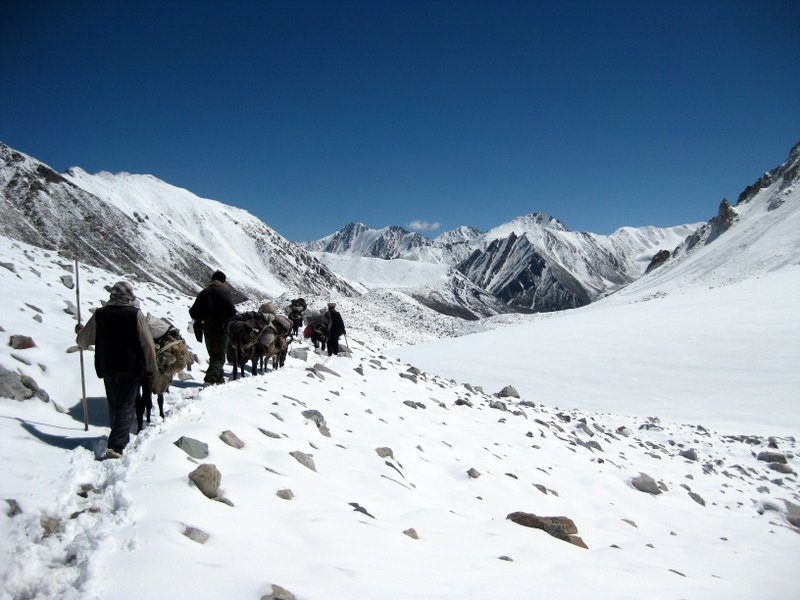The Little Pamir
The Little Pamir is, simply put, another world and has remained unchanged since Marco Polo passed through almost 750 years ago. Crossing 5500m passes between 7500m peaks, passing gargantuan yaks wandering the valleys around yurt encampments a week’s walk from the nearest road, meeting people who have had almost no contact with outsiders – this is just some of what travel here entails.

Plenty of caravans ply a 1-month on foot trade route from Badakhshan, just west of Ishkashim, to the last yurt encampments of the Little Pamir
See the main Afghanistan page for details of how to get to the Wakhan and Little Pamir from Tajikistan without ever having to enter unsafe parts of Afghanistan, and for information on how to get an Afghan visa quickly, cheaply and hassle-free in Tajikistan. See the Wakhan page for details on permits, guides and transport to Sarhad-e-Broghil.
For the first few days of trekking out of Sarhad-e-Broghil, the last village of the Wakhan accessible by road, you are passing through Wakhi territory. Unlike along the Ishkashim-Sarhad road, however, their houses are not built entirely of mud. Their walls are just stones piled one on top of the other, their low roofs made of mud supported by long sticks of wood. They are very cold, especially seeing as at this altitude villages can be buried in snow even in August.
After four days trekking you arrive at Lake Choqmaqtin and the beginning of Kyrgyz territory. The Kyrgyz live in felt tents called yurts and are the last of their people to live year-round nomadic existences, the Kyrgyz in Kyrgyzstan these days living in yurts only in summer then moving to a flat in a nearby town or village during winter.
Starting your trek from Sarhad-e-Broghil (altitude 3300m), the path winds upwards, ascending something like 1000m over two passes. You then have to cross several more mountains before arriving at the first place where it is possible to spend the night, a roofless herders’ shelter called Showr 5 hours from Sarhad-e-Broghil. There’s an overhanging boulder that protects you from light rain, but it would be better to have a tent if you intend to sleep here.
About five hours further, after a very steep mountain climb, is the village of Badge Goz. 3 hours after Badge Goz is the village of Sang Nawishta, the first village in the Chpodkis valley.
From Sang Nawishta it is roughly a five hour walk to the last village of the Chpodkis valley, then a five or six hour walk over a very high pass (pictured above) to Nawebat, the first village of the Warum valley. From Nawebat, through the Warum valley, over the Akbilis Pass to the first yurt encampments of the Kyrgyz is about seven hours total. The closest yurt encampments are Karchynd and Kasch Goz; the furthest, another 2-3 days walk, are Ghund Ji Boi and Qoqtruq.
Therefore, to get to the first yurt encampments is about 30 hours trekking. I did it in 5 days on the way there and 4 days on the way back, but if you walked all day without resting you could do it in 3 days. If you hired a horse you could perhaps even do it in 2.
There is also another, quicker route to the yurt encampments from Sarhad-e-Broghil following the banks of a river. This could be done in 3 days at the same sort of pace of walking as the mountain route could be done in 4. However, there are no villages along the river route, only a few herders’ shelters, and staying with villagers is surely one of the most interesting parts of this sort of travel. Another problem with the river route is that it becomes impassable if the water level is too high.
What to bring with you
* Food! People here eat nasty bread for breakfast, nasty bread for lunch and nasty bread with yoghurt and rice for supper. That’s it, every day. If you’re staying in a village or yurt encampment they’ll provide you with the same meals they eat and salty tea but bring lots of your own supplies, as with so much trekking you’ll starve on just a local diet.
* Warm clothing and a sleeping bag are absolutely essential. No matter what anyone says, bring them even mid-summer as a little bit of cold weather will make you seriously regret you left them behind. A tent is not 100% necessary but if you plan on sleeping at Showr (see above) and it rains or snows hard, you’ll wish you had brought it!
* Altitude sickness medicine. When you’ll be well over 4000m all the time, this is just essential.
* Money. Even if they don’t ask you for it, offer villagers who you stay with beyween US$5 and US$10. These people are seriously poor.
Click here for my blog about the Afghan Pamir, with 8906 words and 38 photos.
Leave a Reply